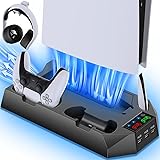The pursuit of the perfect gaming laptop often involves a critical balancing act: raw, unadulterated power versus sleek, go-anywhere portability. This is a common dilemma encountered by enthusiasts and professionals alike, where the choice can define not only your gaming sessions but also your daily workflow. A robust workstation demands specific attributes, while a travel-friendly companion prioritizes others. The video above delves into precisely this comparison, pitting two formidable contenders against each other: the Lenovo Legion Pro 5 and the ASUS ROG Zephyrus G16 (2025).
For those dissecting every specification and contemplating their next significant investment, understanding the nuanced differences between these machines is paramount. Each model brings a distinct philosophy to the table, and while both are titans in their own right, their strengths are allocated differently. This detailed analysis aims to illuminate those distinctions, providing a comprehensive written complement to the visual comparison presented in the video.
Lenovo Legion Pro 5 vs. ASUS ROG Zephyrus G16: Unpacking the Ultimate Gaming Laptop Showdown (2025 Edition)
Design & Aesthetic: Form Meets Function in Modern Gaming Laptops
Upon initial inspection, a striking contrast is observed between these two gaming powerhouses, extending beyond mere color. Both are designed with a “stealthy-ish” aesthetic, ensuring they do not overtly “scream gamer.” However, the Zephyrus G16 exudes a more premium, almost MacBook-esque feel. Its full aluminum body is felt with every touch, conveying a palpable sense of strength and superior build quality.
The Premium Touch: Metal vs. Plastic Construction
The Legion Pro 5, while not lacking in sturdy construction for its materials, features a metal lid but an interior that is predominantly plastic. This construction choice, while robust, results in the device being a “fingerprint magnet.” Conversely, the Zephyrus G16, with its all-metal chassis, proves significantly easier to maintain, especially in lighter color variants, preserving its pristine appearance effortlessly. The tactile difference is notable, with the Zephyrus offering a more luxurious haptic experience.
The Portability Paradox: Weight and Dimensions of Gaming Machines
A primary differentiator is the aspect of portability. Despite its full metal construction, the Zephyrus G16 is considerably lighter and thinner than the Legion Pro 5. This results in a more comfortable carrying experience, particularly for those who frequently transport their laptop. The Zephyrus is engineered to be a companion that can be carried “all day,” whereas the Legion’s extra thickness and weight are often noticed in a backpack, signifying its desktop-replacement aspirations.
The Reflective Surface Dilemma: Display Coatings and Usability
While both laptops feature equally gorgeous OLED displays with near-perfect colors, infinite contrast, and deep blacks, a significant divergence lies in their display coatings. The Zephyrus G16 boasts a glossy screen with a highly effective anti-reflective coating, which notably mitigates distracting reflections. In contrast, the Legion Pro 5’s display, described as akin to a “mirror,” struggles with ambient light, making it challenging to use near windows or other light sources. This reflectivity can significantly impact the device’s overall usability and viewing experience, irrespective of its stellar panel quality. Furthermore, the Zephyrus’s glass display integrates more seamlessly compared to the Legion’s plastic bezel and pronounced webcam bump, adding to its premium visual appeal.
Performance & Power: The Heart of the Beast in High-End Laptops
The additional heft and thickness of the Legion Pro 5 are not arbitrary; they directly correlate with its capacity for superior performance. This extra volume is allocated for a more substantial cooling solution, which is fundamental to dissipating the greater heat output generated by higher power delivery. Such thermal management allows for sustained, high-wattage operation, making a significant difference in overall performance metrics.
CPU Prowess: Raw Horsepower and Thermal Headroom
The Legion Pro 5 is often equipped with some of the fastest laptop CPUs available globally. Its Intel Ultra 9 275HX chip, for example, is a testament to unbridled processing power. While the Zephyrus G16 can feature the Ultra 9 285H, this version is comparatively “knee-capped” in terms of its power limits, primarily due to its more constrained thermal envelope. In benchmarks like Cinebench, the Legion’s superior thermal design is immediately evident, scoring nearly double that of the Zephyrus. This demonstrates its ability to sustain peak CPU performance for extended periods, a critical factor for demanding computational tasks.
GPU Dynamics: Wattage, Benchmarks, and Real-World Gaming
Regarding GPU performance, the wattage difference between their graphics cards might not appear as stark in synthetic benchmarks like 3DMark TimeSpy, where both devices perform quite closely. However, the real-world gaming experience tells a different story. The Zephyrus G16 offers options for higher-spec GPUs, including up to an RTX 5080 or even a 5090. Nevertheless, these higher-tier GPUs within the Zephyrus are still subject to more stringent power limitations compared to the Legion, which impacts their peak potential.
Understanding the Power Envelope: A Deeper Dive
The concept of a “power envelope” is crucial in understanding these performance discrepancies. This envelope is dictated not only by the wattage provided by the power brick but, more critically, by the laptop’s ability to dissipate heat. The Zephyrus, being thinner and lighter, possesses a smaller cooling solution, leading to lower power limits. This adheres to fundamental thermodynamic principles. The Legion, conversely, benefits from a “beefier, bigger cooling solution,” enabling it to utilize more power and expel more heat efficiently.
During mixed workloads, such as gaming, where both the CPU and GPU are heavily engaged, this larger power envelope becomes indispensable. The Legion’s CPU and GPU can freely access ample power headroom. The Zephyrus’s components, however, must constantly contend for and “swap watts” due to the laptop’s limited thermal capacity. Consequently, even if their GPUs benchmark similarly, the Zephyrus’s GPU performance can be noticeably diminished during gaming when a significant portion of its allotted power is reallocated to the CPU. This results in the “Legion being faster because it’s thicker, and the Zephyrus being slower because it’s thinner.”
Gaming Performance Data: FPS Benchmarks Explained
In real-world gaming scenarios, the performance difference between the Legion Pro 5 and the Zephyrus G16 becomes undeniably apparent:
- Battlefield 1: Legion Pro 5 averages 156 FPS, while the Zephyrus G16 averages 148 FPS.
- Counter Strike 2: The Legion Pro 5 reaches an impressive average of 271 FPS, significantly outperforming the Zephyrus G16 at 179 FPS.
- Oblivion Remastered: Legion Pro 5 maintains an average of 92 FPS, compared to the Zephyrus G16’s 69 FPS.
- Cyberpunk 2077: An average of 88 FPS is observed on the Legion Pro 5, with the Zephyrus G16 achieving 71 FPS.
- Rust: The Legion Pro 5 delivers an average of 88 FPS, while the Zephyrus G16 yields 73 FPS.
- Red Dead Redemption 2: Legion Pro 5 averages 77 FPS, whereas the Zephyrus G16 averages 62 FPS.
These figures clearly demonstrate the Legion Pro 5’s consistent advantage across a range of titles, particularly in CPU-intensive or graphically demanding games where sustained power is critical.
User Experience Enhancements: Beyond Raw Specs
The overall user experience is profoundly influenced by design choices extending beyond raw performance metrics. Aspects such as input devices, audio quality, and pre-installed software contribute significantly to daily interaction with a laptop. These elements often dictate the enjoyment and productivity derived from the device.
Keyboard and Trackpad Ergonomics for Discerning Users
The keyboard experiences offered by these two laptops are notably distinct. The Zephyrus G16 features an RGB backlight with a single lighting zone and keys that possess a more “full” and softer plastic feel, often preferred for its tactile comfort. In contrast, the Legion Pro 5 boasts 24 lighting zones, one for each vertical row of keys, offering more sophisticated lighting options, though it does not reach the granular control of per-key RGB. Its keys are distinctly “clickier,” providing a satisfying auditory and tactile response. Additionally, the Legion includes full-size arrow keys and a numpad, appealing to users who require these for data entry or specific gaming macros. The Zephyrus, while lacking a numpad and featuring half-size arrow keys, compensates with four reprogrammable macro keys, enhancing its versatility for specific applications.
Trackpad differences are equally pronounced. The Zephyrus G16’s glass trackpad immediately conveys a more premium feel compared to the Legion Pro 5’s plastic equivalent. The Zephyrus offers a deeper, more refined click, indicative of higher quality. The Legion’s trackpad, while functional and clicky, can feel comparatively cheaper. Furthermore, the size of the trackpads also varies significantly, with the Zephyrus’s often being substantially larger, contributing to a more comfortable and precise navigation experience.
Audio Fidelity and Webcam Clarity: Multimedia Capabilities
Audio performance stands out as a strong point for the Zephyrus G16. Its speaker system, featuring subwoofers on the bottom and top-firing speakers, delivers richer bass, greater volume, and superior clarity, along with impressive surround sound. The Legion Pro 5, with its bottom-firing speakers, can sound comparatively “lacking in bass and volume,” particularly when lifted off a surface. The Zephyrus’s audio system is considered among the best in the laptop market. While the Zephyrus also offers a better-sounding microphone, the Legion Pro 5 counters with a “really good-looking, high-quality webcam,” a feature increasingly valued for video conferencing and streaming.
Software Ecosystems: Customization and Control
The software landscape also differentiates the user experience. The Zephyrus G16 is typically pre-installed with Armoury Crate, though open-source alternatives like G-Helper are favored by some for their simplicity and comprehensive control over fan curves, GPU overclocking, and custom power limits for both CPU and GPU. Crucially, these advanced options remain accessible even when the laptop is unplugged. The Legion Pro 5 utilizes Legion Space, which offers commendable performance customization, particularly with its custom power profiles. However, many of these options become unavailable once the laptop is disconnected from its charger, a common limitation among gaming laptops. This makes the Zephyrus, with its persistent customization options, arguably more versatile for users who require consistent performance profiles regardless of power source.
Connectivity and Port Selection for Versatile Use
Port selection varies slightly, catering to different user needs. The Legion Pro 5 generally offers a marginally better array of ports, notably an additional USB-A port and a full-size Ethernet port, which is invaluable for stable, high-speed wired internet connections. Conversely, the Zephyrus G16 includes an SD card reader, making it a more appealing option for content creators, photographers, and videographers who frequently transfer media. Both laptops support USB-C charging, providing flexibility for on-the-go power solutions, potentially mitigating the “gigantic” power brick that accompanies the Legion Pro 5, necessitated by its higher power demands.
Battery Life, Thermals, and Upgrade Potential
Beyond the immediate performance and user interface, factors such as battery longevity, thermal management, and future upgradeability play a significant role in a laptop’s long-term utility and value. These aspects contribute to the practicalities of ownership and the adaptability of the device over time.
Endurance on the Go: Battery Performance Considerations
Both the Legion Pro 5 and the Zephyrus G16, being equipped with Intel chips of this generation, are observed to have less than ideal battery life, especially when compared to their AMD counterparts. In light use scenarios, such as playing YouTube videos at full brightness and 60Hz with dedicated GPUs disabled, the Zephyrus G16 demonstrates a slight edge in endurance. However, neither laptop offers exceptional battery performance, a characteristic often associated with powerful gaming machines. When engaged in gaming on battery power, both devices exhibit very limited runtimes. It is made clear that neither laptop is designed for extended gaming sessions without being plugged in, a crucial expectation to manage for potential buyers.
Heat Management and Acoustic Profiles During Intensive Use
Despite their architectural differences, both laptops demonstrate comparable thermal performance. Under the most demanding gaming conditions, their CPUs typically reach similar maximum temperatures, around 90 degrees Celsius. The Zephyrus G16’s GPU may run slightly cooler, but the difference is not substantial. These temperatures, while on the warmer side, are well within operational limits and do not indicate thermal throttling. It is impressive how effectively the Legion manages to cool such a powerful chip within a relatively thinner chassis. However, the laws of physics dictate a trade-off: where there is heat, there is noise. The Legion Pro 5 is distinctly louder under heavy load, a consequence of its more aggressive cooling system working to manage its higher thermal output.
Future-Proofing: RAM and Storage Upgrades for Longevity
Upgradeability is a critical factor for extending the lifespan and enhancing the capabilities of a laptop. Both the Legion Pro 5 and the Zephyrus G16 facilitate upgrades to their Wi-Fi cards and include two M.2 SSD slots, allowing for ample storage expansion without needing to replace the primary Windows drive. A notable distinction, however, lies in their RAM configurations. The Legion Pro 5 offers fully upgradeable RAM, providing users with the flexibility to increase memory capacity as future demands evolve. In contrast, the Zephyrus G16 features soldered RAM, which severely limits upgrade options and is a significant consideration for users who anticipate needing more memory down the line.
Value Proposition and Final Considerations
Ultimately, the decision between the Legion Pro 5 and the Zephyrus G16 often hinges on the interplay of performance, portability, user experience features, and, crucially, cost. Each laptop presents a compelling case, but their ideal users diverge based on priorities.
Pricing Structure and High-Tier Options
The pricing structure represents a significant differentiator. The Zephyrus G16 typically commands a higher price point, frequently being between $300 to $700 more expensive than comparable configurations of the Legion Pro 5. While both models offer lower-spec, more affordable options, the Legion consistently maintains a more budget-friendly position across its lineup. The Zephyrus does provide access to even higher-spec models, featuring GPUs like the RTX 5080 or 5090. However, these configurations are exceptionally expensive and, as previously discussed, are still subject to power limitations, which can curtail their full performance potential in real-world scenarios.
Tailoring Your Choice: Who Should Buy Which Gaming Laptop?
The choice between the Legion Pro 5 and the Zephyrus G16 is not about absolute superiority but rather about aligning the laptop’s attributes with individual usage patterns and preferences. The Legion Pro 5, while thicker, heavier, and perhaps perceived as having a less premium build than its counterpart, offers considerably faster performance. Its robust cooling system and higher power limits translate directly into superior in-game frame rates and sustained computational prowess.
Conversely, the Zephyrus G16 distinguishes itself through its exceptional portability, thinner profile, lighter weight, and undeniably superior build quality. Its display, with its effective anti-reflective coating, often provides a more pleasant viewing experience, and its speakers are in a class of their own. This makes the Zephyrus an excellent all-around laptop, suitable not only for gaming but also for a wide range of non-gaming activities where a premium, highly portable device is desired.
Therefore, a clear recommendation emerges: if your primary domain of operation is a fixed desk setup, and frequent mobility with your laptop is not a paramount concern, the Legion Pro 5 is the more logical choice. Its performance benefits will be fully realized without the constraints of portability becoming an issue, and its overall value proposition is stronger. However, if daily mobility, a premium feel, and a sleeker form factor are at the top of your list, the Zephyrus G16 is the unequivocally better option. It delivers a refined user experience that extends beyond raw gaming benchmarks, making it ideal for those who demand a versatile and elegant mobile computing solution.









